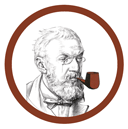|
> Bibliographie commentée > Quelques sites internet Quelques sites internet |

- Le site Manifold Atlas Project, hébergé par l’Institut Max Planck de Mathématiques de Bonn.
Voici un extrait de la présentation du site :
« The mission of the Manifold Atlas is to empower and engage topologists, geometers, historians and philosophers to organize and create knowledge about manifolds and the study of manifolds.In particular we focus on constructions and invariants, general theory and open problems while providing a forum for posing and answering questions. We also plan to build up historical information. »
- Le blog Geometry and the imagination de Danny Calegari.
Voici un extrait de la présentation du blog faite par son auteur :
« In 1932, David Hilbert and Stefan Cohn-Vossen authored an unusual book (based on a course taught by Hilbert in 1920-21) entitled Anschauliche Geometrie (literally : descriptive, or intuitive geometry). I have recently learned from Constance Reid’s biography of Hilbert that he taught this course in order to attract young men returning from the war to the study of mathematics, choosing a subject which could be presented in a lively, intuitive style. [...]In the very(?) late 80’s, Peter Doyle, John Conway, Jane Gilman and Bill Thurston taught an introductory course on geometry at Princeton, using Geometry and the Imagination as the title of the course. An expanded version of this course was taught at the Geometry Center in 1991 ; notes from the course are still available. The “philosophical statement” at the start of these notes includes the following inspiring thought :
Imagination, an essential part of mathematics, means not only the facility which is imaginative, but also the facility which calls to mind and manipulates mental images. One aim of the course is to develop the imagination.
My intention in writing this blog is to try to follow in the steps of H-CV-D-C-G-T in a new medium, and to explore geometry through examples, through ideas, and through images (mental or otherwise). Geometry is a method and a philosophy, but it is in addition a psychological attitude, and this blog aims to celebrate geometry in all its aspects, both as a science and as one of the humanities. »
- Le blog Visual Insight de John Baez, hébergé par l’AMS.
L’auteur présente de manière très succincte son blog :
« Visual Insight is a place to share striking images that help explain advanced topics in mathematics. I’m always looking for truly beautiful images, so if you know about one, please tell me ! »
De temps en temps, les explications des « images frappantes » font intervenir de la topologie algébrique.
- Le site Imaginary, initié au Mathematisches Forschungsinstitut Oberwolfach en Allemagne.
Voici les premières phrases de présentation du site :
« IMAGINARY is a platform for open and interactive mathematics. It features a variety of content that can be used in schools, at home, in museums, at exhibitions or for events and media activities. The main contents of IMAGINARY are its interactive programs and its picture galleries. »
Ses galleries, programmes interactifs et videos permettent de se familiariser visuellement avec des objets très riches géométriquement ou topologiquement.
- Le Topologicon de Jean-Pierre Petit. Pas tout à fait un site internet, mais plutôt une bande dessinée.
En avertissement, on lit :
« Il est déconseillé au lecteur de lire cet album :
- le soir avant de s’endormir,
- après un repas trop riche,
- ou quand on n’est sûr de rien, car cela risquerait d’aggraver les choses. »
- Le site internet de Allen Hatcher contient un certain nombre d’informations utiles. Outre ses livres sur la topologie algébrique, qui sont non seulement très pédagogiques, mais aussi accessibles en ligne, on trouve aussi une bibliographie commentée.

